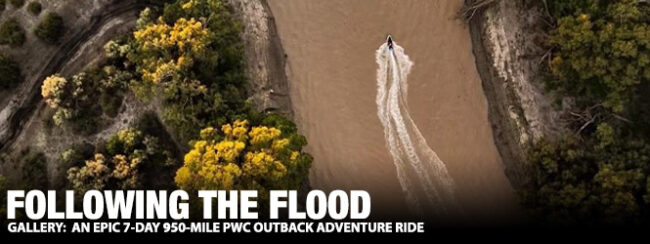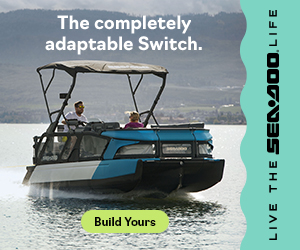
One of the major limitations of riding PWCs in Australian rivers is whether or not they actually have any water in them. As the driest inhabited continent, many of the country’s major rivers are often dry, awaiting the eventual floods. Australia’s second largest river, the Darling, is one such example.
Having last seen water in 2016, the 950 mile (1500 km) long river finally flooded again in 2022. It is a real story of one extreme to the other – years of arid conditions followed by torrential, bank busting floodwater.

Waiting in preparation for the return of the Darling River floods was an intrepid group of PWC adventurers. Once the river filled with water, they cast off at the junction that forms the beginning of the Darling River, and rode its entire length through the outback over a period of 7 days.
One of the team even recorded the full journey with a special Google Earth camera, so in time the service will allow users to zoom in and virtually tour the river. The Watercraft Journal interviewed team member Brendan Whitty, a.k.a. ‘Doug’ about this epic jet ski adventure.

The Watercraft Journal (WCJ): Have you planned or been on jet ski adventures of this size before?
Doug: We’ve planned a few trips over the years. Last November the same group completed the length of the Murrumbidgee from below the Burrinjuck Dam near Canberra to its confluence at the Murray River. That trip was about 1300 kilometres [800 miles] over 5 days.
Prior to that, myself and some other friends jet skied the 2200 kilometre [1350 miles] length of the Murray River from Yarrawonga down to Goolwa in South Australia. We raised [AUD] $26,000 for The National Centre for Farmer Health in 2019 on that trip.

WCJ: How many riders, what jet skis were they riding, and how many support vehicles were on the trip?
Doug: There were 6 riders: Myself, Brendan Whitty (aka Doug) riding a Sea-Doo 2022 Spark, Andrew Thompson on a 2022 Spark, Aaron Tarbitt also on a 2022 Spark, Dean Freeman rode a Sea-Doo 2022 GTI 130 and had the Google Camera, Dan Bell on a Sea-Doo 2015 GTI 155, and Scotty Graham on a Sea-Doo 2012 Wake Pro.
Each jet ski required its own support vehicle in case it required recovery due to a breakdown (fortunately there were none), and also to retrieve the skis at Wentworth because it’s the best part of 800k kilometres [500 miles] from Bourke to Wentworth by road. All up it was a great team and we had some great laughs for the week.
Three of us purchased Sea-Doo Sparks for the trip and they were definitely an excellent choice. They were light and nimble and easy to recover over the very steep river banks. The other skis performed well also, apart from a few nicks and scrapes.

WCJ: What for you were the most enjoyable and significant parts of the adventure?
Doug: The highlights of the trip were definitely the accommodation venues. The Tilpa Pub is just so remote and inaccessible during these floods. The town has been isolated by the flood waters for some time. Apart from the few locals we were its only visitors since late January.
Visiting the Station properties like Rose Isle, Dunlop, Trilby and Marra Station en route was also significant. We were enthusiastically welcomed along every stage of the journey and the locals were fascinated by the challenge we had undertaken.

WCJ: What was the hardest part of the journey?
Doug: The hardest part of the journey was definitely recovering and relaunching skis around the weirs [a small dam built across a river to control the upstream water level – Ed.] on the first few days. Notably at Wilcannia. The winch on the trailer snapping at the most inopportune time, winding the ski up. Then there was the 40 metre [yard] launch the next morning down the embankment.
It is surprising the lack of boat ramps in many of the towns. Everyone worked very cohesively together and all tasks were completed with surprising precision. A special mention for a star roadie, Sam, who just dived into every challenge and made short work of it.
By Thursday we had caught up to the slow moving flood waters and we were now riding up along the top of the banks. After Wilcannia, all the weirs and bridges were submerged under the flood waters and although turbulent at times we passed over them unimpeded. At the start of the trip we were 10m below the horizon as if we were in an open top tunnel.

WCJ: What was the biggest mishap or near disaster you had on the trip?
Doug: We prepared as best we could for the unexpected and on the skis we carried tool kits, spare parts, first aid kits, Satphone, Garmin Trackers, etc., but apart from the winch that snapped, one of our most difficult moments was probably also one of our best.
Crossing Dunlop Weir proved a challenge on a number of levels. We could only carry enough fuel to go in one direction. Turning around and going back wasn’t an option. The Sparks were precariously balanced with 110litres of fuel on a couple of days. Many of the roads were inaccessible or closed due to flooding so the road crews often waved us off in the morning and met us at the destination that night.

The road crews were required to take very long detours to reach the next town. So each day we were committed to make the destination regardless of the obstacles as we didn’t have sufficient fuel to go back. We were all well aware that if a ski was actually incapacitated that it may have to be abandoned for weeks (or months) until it could be recovered.
At Dunlop Weir, due to the flood waters the road crew could not gain access across the Station Property for recovery, so we were obliged to rope the skis over the weir. The rapids and blue stone boulders proved a logistical challenge, but it was achieved apart from a pair of wet suit booties that the currents ripped off a pair of feet and a couple of small chunks torn from the larger skis. One of the bigger challenges on the day that left us with grins on the other side.

WCJ: With water the color of mud, did you avoid groundings and stump strikes, etc?
Doug: There were no groundings or stump strikes or ‘low hanging tree branches’ that could not have been avoided. I am just going to leave that there…
WCJ: What wildlife did you see and/or encounter?
Doug: There were heaps of animals. Goats were prolific! But plenty of bird life too, big and small. Who knew emus could swim? We were surprised to see them swim across the river on a couple of occasions.
There were a gazillion ducks. As we approached them on the skis the flock would take off in front of us. They invariably all seem to defecate in unison before us in a barrage that we had to ride through. Here is a tip: wear goggles and don’t lick your lips after passing underneath just such a flock of ducks.

WCJ: Any memorable reactions from people when they saw jet skis coming down the Darling River?
Doug: People travel the Darling in kayaks and tinnies sometimes according to the locals, but PWCs were definitely a novelty. I think we equally enjoyed taking kids for joy rides as they did engaging with us.
We were asked to keep an eye out for a kayaker named Tanya. Tanya’s family had been calling towns and properties along the river concerned for her safety as they hadn’t heard from her for a few days. We came across her near Louth and lent her a phone. She was OK, she was just out of communication range for some time.

We were also given the news that it was her 40th birthday, so as we arrived and idled up to her we all broke into chorus with a rendition of “Happy Birthday.” She was pretty blown away considering how isolated she thought she was.
WCJ: Do you have any plans for a new jet ski adventure ride or a return trip down the Darling?
Doug: We loved the trip along Darling and we would do it again in a heart beat just for the experience of engaging with the locals. The people we met on the trip were definitely the highlight.
I am planning to ride across Bass Strait from Victoria to Tasmania again soon but those plans aren’t locked in just yet.
WCJ: Thanks Doug, and congratulations on an amazing journey!
Some of Doug’s previous PWC adventures can be found on this YouTube channel:





























